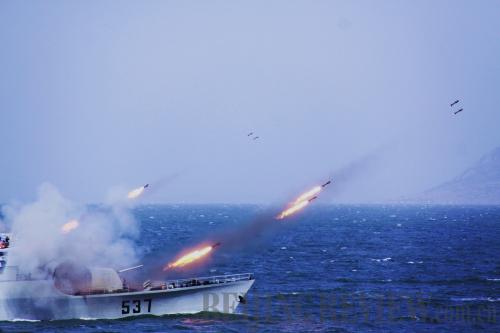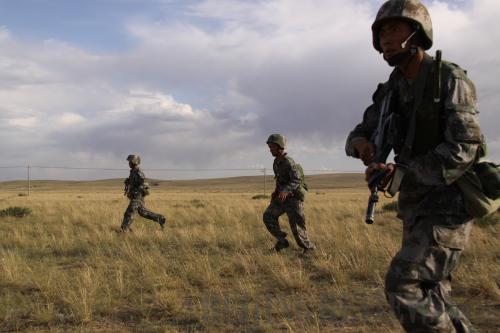|
|

|
|
SEA ATTACK: Frigates of the PLA Navy carry out a live-fire exercise LIU FENGAN | The "Iron Cavalry 2009" military exercise of mechanized troops explored new ways to organize combined battle groups to carry out actual troop exercises under information-based conditions.
Chinese military exercises have become increasingly transparent. The amount of media coverage of China's military exercises was unprecedented in 2009. According to incomplete statistics, Chinese media organizations had covered 18 military and non-military exercises by the end of November 2009. The "Stride 2009" trans-MAC military exercise was widely reported on issues from the long-distance maneuvers to the upgrading of soldiers' equipment and eyewitness accounts of the exercise.
Of the 18 exercises, the "Victory 2009" adversarial exercise and the "Vanguard 2009" ground-air joint fire strike exercise were opened to foreign military personnel. More than 200 foreign military officers, cadets studying in China and military observers were invited to watch the two exercises.
The PLA also participated in six joint military exercises with foreign armed forces in 2009. China's special operations troops made their debut in the "Peace 09" multinational maritime joint military exercise in Pakistan; Chinese military medical workers held the first joint medical service support exercise with their foreign counterparts in the "Peace Angel 2009" China-Gabon joint humanitarian medical rescue operation; the PLA conducted the first joint training in the security field with foreign troops in the Sino-Singaporean "Cooperation 2009" joint security and guard training; and the PLA staged its first joint peacekeeping training with a foreign military in the "Peacekeeping Mission 2009" China-Mongolia joint peacekeeping exercise. Among the six joint military exercises, the "Peace Mission 2009" Sino-Russian joint antiterror military exercise is regarded as the most important.
The intensive media reporting and the high-degree of openness of the exercises indicate the constant improvement in China's military transparency. Joint military exercises between Chinese and foreign armed forces embody China's sincerity to strengthen military exchanges and mutual trust with other countries.
The Chinese armed forces are also paying more attention to enhancing their capacity to accomplish MOOTW operations.
In the wake of the devastating 8.0-magnitude Wenchuan earthquake in southwest China's Sichuan Province in May 2008, more than 100,000 troops became the pillar in rescue operations. The increasing importance of MOOTW operations enabled them to be listed as training items in the latest version of the Outline of Military Training and Evaluation.
The largest two MOOTW drills undertaken by the Chinese military in 2009 were the "Great Wall 6" antiterror exercise and the "Luhai 2009" military-police-civilian maritime joint search and rescue exercise.
"Great Wall 6," which took place in provinces surrounding Beijing in June, aimed at improving policing capacities to deal with possible terrorist attacks and other security emergencies that could happen during celebrations of the 60th anniversary of the founding of the People's Republic of China. The scenario of terrorists triggering dirty bombs that released radioactive contaminants was simulated during the drill.
During May's "Luhai 2009" joint search and rescue exercise, the military, police and civilian forces launched a joint search and rescue operation on a fishing boat in distress. The mission's objective was to save drowning passengers and give them first aid.
The PLA and the Armed Police Force will participate in more joint MOOTW exercises in the future.
 |
| LONG MARCH: Nearly 50,000 soldiers from four military area commands participate in a long-distance combat exercise codenamed "Stride 2009" LIU FENGAN |
The author works for the People's Liberation Army General Staff Department | 